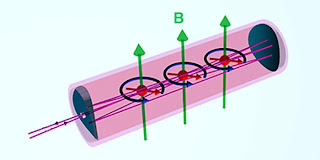 |
| Illustration showing the magnetic spins precessing with respect to the magnetic fields. (Courtesy: J Shi/Princeton University) |
An atomic magnetometer that can detect magnetic fields one hundred billion times smaller than the Earth's and does not require stringent shielding from the Earth's own field has been developed by an international group of researchers. The device is based on multi-pass atomic vapour cells and, the team says, can be used in various magnetic sensing applications such as measuring biological magnetic fields and land-mine clearance, as well as in geology and fundamental physics experiments.
Atomic magnetometers work by detecting how the energy levels of atoms are modified by an external magnetic field. This is the famous Zeeman effect – a quantum effect whereby the magnetic spin states in an atom split in the presence of an external magnetic field. This interaction between the atomic magnetic moment and external field is used to measure the field. This is normally done by using a pump laser to "polarize" the atoms by populating specific spin states, while a probe laser measures the spin precession, which is proportional to the magnetic field.
Physics World: Atomic magnetometer is most sensitive yet
Comments